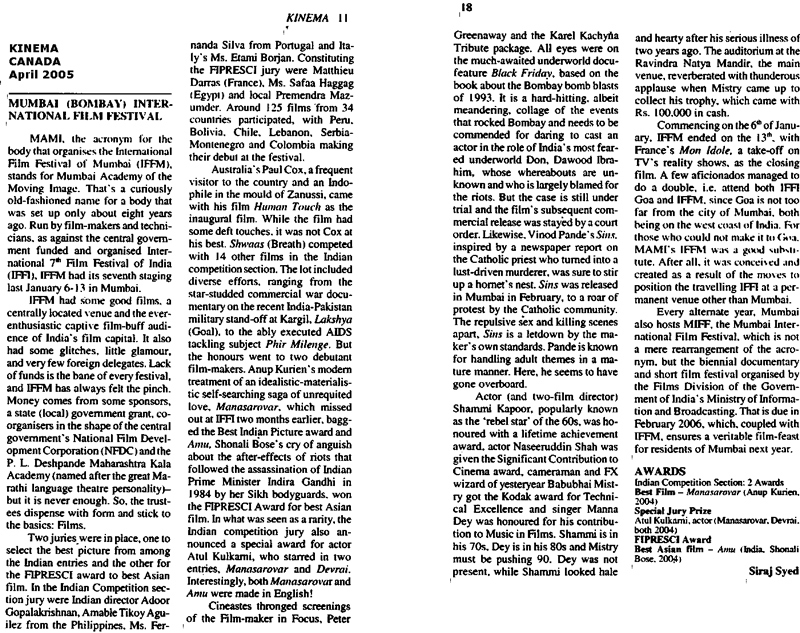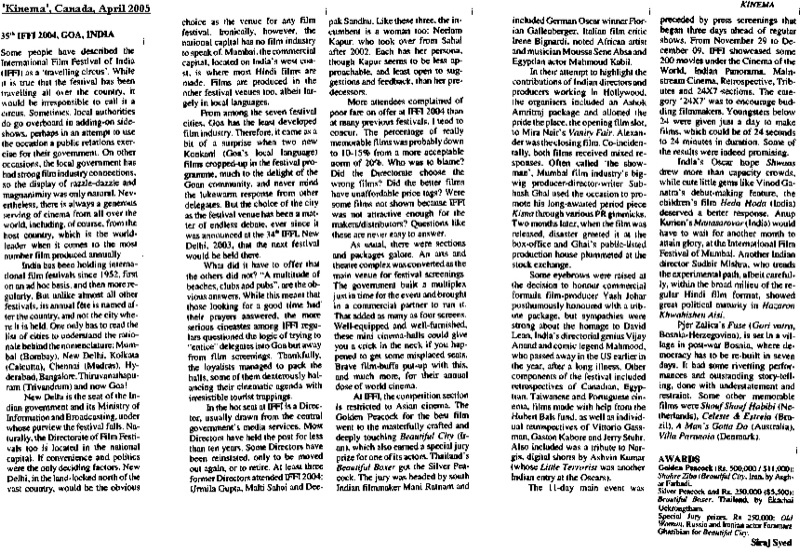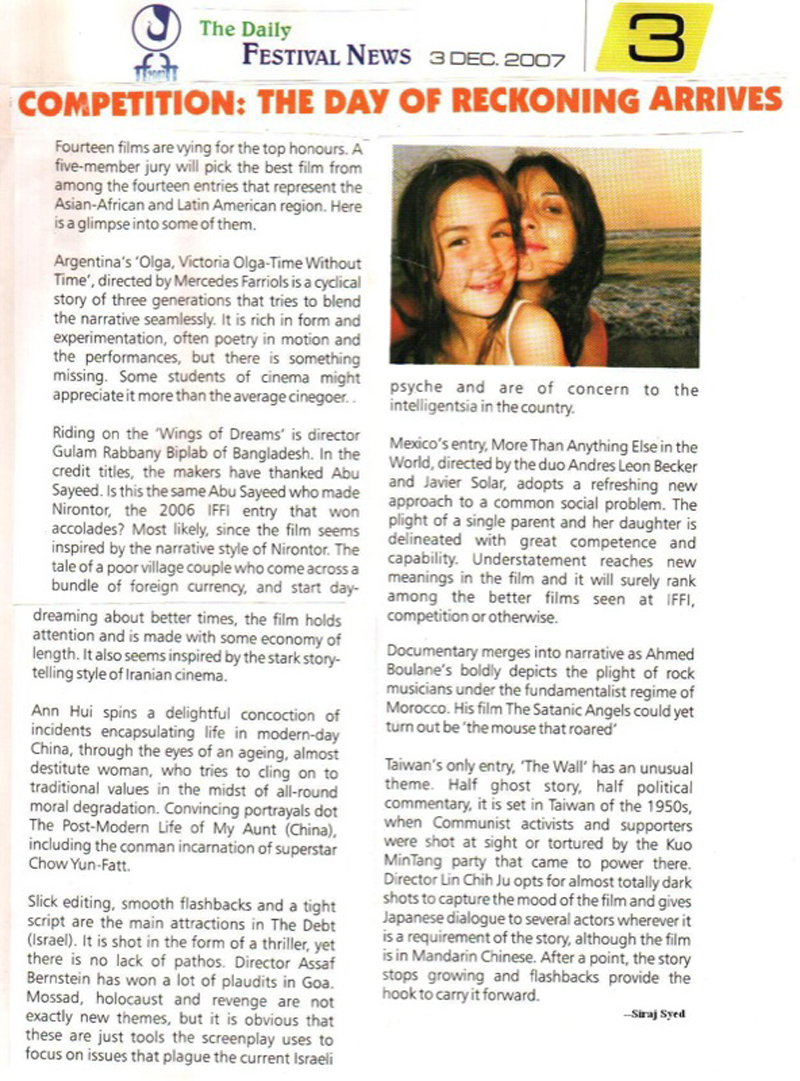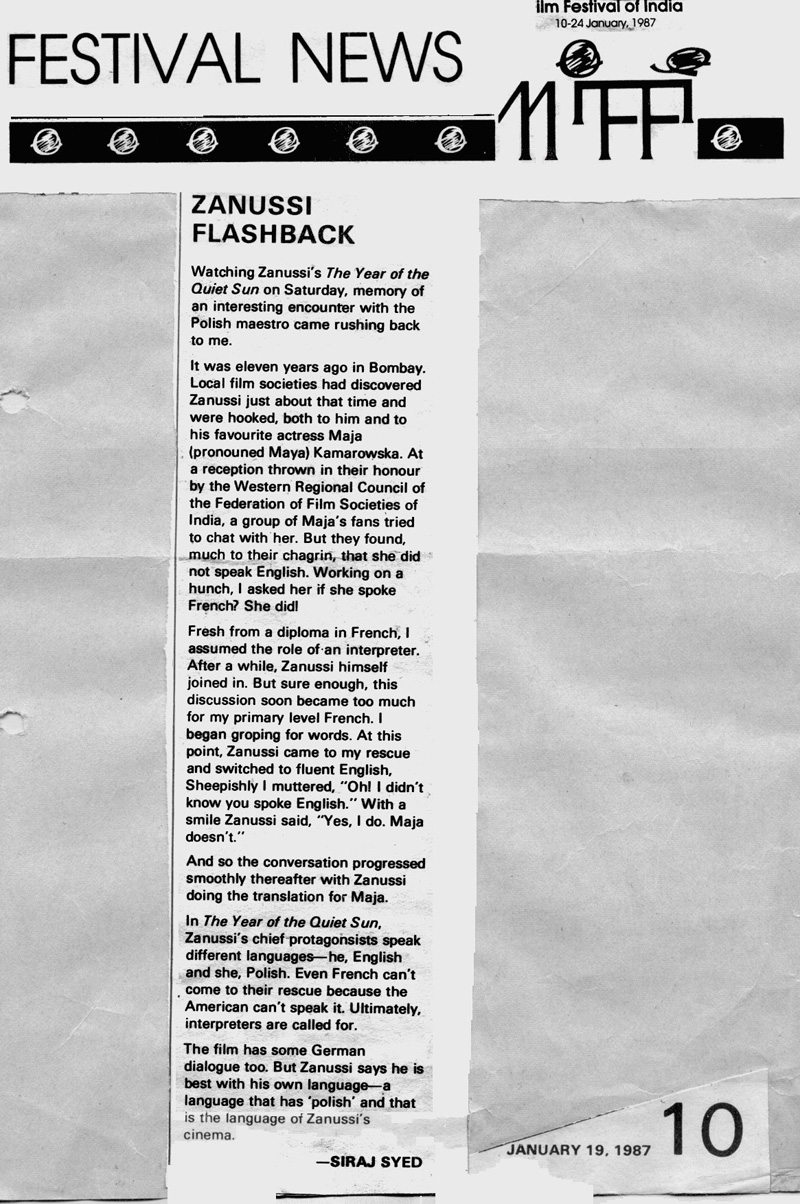|
|
||
|
Pro Tools
FILMFESTIVALS | 24/7 world wide coverageWelcome ! Enjoy the best of both worlds: Film & Festival News, exploring the best of the film festivals community. Launched in 1995, relentlessly connecting films to festivals, documenting and promoting festivals worldwide. We are sorry for this ongoing disruption. We are working on it. Please Do Not Publish until this message disappears. For collaboration, editorial contributions, or publicity, please send us an email here. User login |
Siraj SyedSiraj Syed is the India Correspondent for FilmFestivals.com and a member of FIPRESCI, the International Federation of Film Critics. He is a Film Festival Correspondent since 1976, Film-critic since 1969 and a Feature-writer since 1970. He is also an acting and dialogue coach. @SirajHSyed  Anahita’s Law, Review: Parsee patriarchy, woes of women and law of the land
Anahita’s Law, Review: Parsee patriarchy, woes of women and law of the land Discrimination against women, and children of mixed religion marriages, are not phenomena that stare us in the face, like some of the basic needs of mankind: food, clothing and shelter. It is not even a second tier priority, like electricity, roads and water are. In a country struggling to provide these amenities to its population of 1.6 bn, implementing the fundamental right to practice the religion of your choice is not high on the priority list of the powers that be. Nevertheless, it must be realised that inter-religious marriages, and progeny of married women who give birth to babies conceived outside wedlock, could wreak havoc in closed societies, especially among minority religions like the Parsees. Oorvazi Irani brings into sharp focus tales of such women and their children, in luminous vignettes, with poetic, ballet-like grace, and calls it Anahita’s Law. She premiered it in an art gallery in Mumbai last week, and has released it on Humaramovie You Tube channel yesterday. My review, however, is based on a Vimeo screener. The film derives its name from Anahita (the spirit of Aphrodite/all powerful, almighty/the first woman, according to the film) that is used as a first name too, not too common, and not uncommon either. (I know two Anahitas but no Oorvazis). Anahita became a Zoroastrian Yazata (or Angel), and is still part of contemporary Zoroastrianism. Described as a beautiful maiden, who is strong, tall and pure, she is depicted as wearing a mantle, embroidered with gold, and as holding the baresma (sacred plant) in her hand. She is the Goddess of all the waters upon the earth, her full title being Aredvi Sura Anahita, which means moist, mighty and immaculate (pure), and she travels on her chariot, pulled by four horses: Wind, Rain, Cloud and Sleet. She has some remarkable similarities to numerous other ancient goddesses, including Ishtar, Venus, Nana and Isis. Britannica.com defines a Parsee as “…a member of a group of followers in India of the Iranian prophet Zoroaster (or Zarathustra). The Parsees, whose name means “Persians,” a variation of the word Farsi, which means Persian, the language, are descended from Persian Zoroastrians who immigrated to India in the 8th -10th century, to avoid religious persecution by Muslims who ruled Iran at that time. They live chiefly in Mumbai, and in a few towns and villages, mostly to the north of Mumbai, but also at Karachi (Pakistan) and Bengaluru (Karnataka, India). Although they are not, strictly speaking, a caste, since they are not Hindus, they form a well-defined community. According to the 2011 Census of India, there are only 57,264 Parsees in India. Going by Demographic trends, it is projected that by the year 2020 the Parsees will number only 23,000. After making Anahita’s presence felt over the first 3 min. 30 sec. of the film, holding fort about issues ranging from the genesis of men and women, seed and fruit, to the womb (“In the beginning was the womb, and the womb was woman”), the film unfolds a seamless compilation. Compilation seems not the right the word to describe the 21.20 minute film, because all the three ‘stories’ are interpreted and narrated by the director herself, as actor/performer. (Three, because the “triad and trinity are powerful tools in art and design,” avers Anahita). You could call the first tale as part of a story-telling session, in an experimental theatre, before a select invited audience. This one is about a woman called Khurshed, who falls victim to destiny, and how a patriarchal society condemns children born outside marriage, whatever be the circumstances in which the baby was conceived. It rues societies in which babies that physically, as in their skin and eye-colour for example, do not conform to genetic codes, and are refused a place even in houses of worship. The section is about 11 min. 30 sec. long, and about 2 min. too long. In this chapter that Oorvazi plays a kind of double role, one as a woman in her twenties and another as an octo/nonagenarian. It used to take up to three hours for the prosthetic make-up to make Oorvazi look the parts, she being 42 in real-life. Irani goes on to narrate another story on a similar theme, this one being about a Parsee woman named Bakhtawar, a lawyer, who marries a Hindu man with the surname Patel, which is common to Gujarati Hindus, Gujarati Muslims and Parsees, and what happens when it is revealed to the community that her husband is not a Parsee Patel. She talks about the Indian Constitution and Laws that are silent on this aspect of social maladies, and is optimistic about reforms coming in soon. Visual interest is generated and kept alive by the variety of portraits painted with beams of light and shadows, some exquisitely textured frames, giving new meanings to mid-close shots, close-ups and extreme close-ups: two Oorvazis facing each other in profile, a blinking eye as a stylized cutting point, and so on. Pieces of in-sync narration alternate with occasional voice overs, in brief, silent, mid-close shots. (This is a practice that is common to modern film-making, and often used in the picturisation of songs and music videos, but works effectively hereto, to break the monotony of monologues). Educationist (she taught Film Appreciation at the Digital Academy, where this film has been shot, premises offered gratis), acting coach, critic (uh oh!) and film-maker, Oorvazi Irani has made a feature film earlier, called The Path of Zarathustra, which, like Anahita’s Law, was produced by her company, SBI Impresario, founded by her father Sorab, in 1975, and of which she is a director. She also made Mamaiji, based on her grandmother, her debut film. The feature was a difficult and abstract movie, wrapped in over-the-top performances, including one from wonderful actor Tom Alter, who has passed away since. Perhaps she learnt from the feedback about her last venture, and so here, while she has retained some of the elements like lighting, shadows and colours (mainly black and white and skin tones, but shot in colour), the dialogue-based telling has been made easy on the audience, with one actor, and a thousand words coming from her mouth, a long monologue, as it were. Yes, occasionally, the words drop in volume, as if uttered in a trance like state, but she soon cuts to another painting like image, shifting from impressionism to expressionism, smoothly. (Remember, I saw the movie on Vimeo). Meanwhile, viewers can interpret those words as pictures. Her make-up as a grandmother is flawless, what with the big mole on the left of her face for effect, a nod to her real-life maternal grandmother, who was the subject of Mamaiji. Though she varies her pitch to sound older, she does not go over the top, to try and sound like she was stereo-typically 90, and wisely so. In the context of her mise en scène, such an effort would stick out like a sore thumb and could sink into caricature. Often, her only movement is shifting of the gaze, from towards the camera to downwards, with the barest twitches of muscles and the slightest arching of her eyebrows. Then, she looks-up again. Was she taking a sneak-peek at the script because she was forgetting a line? Keep guessing. Farrukh Dhondy (British-Indian; Bandit Queen, Mangal Pandey, The Path of Zarthustra) , another Parsee, has written the screenplay, based on his experiences in his native Pune, and then in Bombay (now Mumbai). Yet, this is very much an auteur film, as Oorvazi is joint producer-director-actor (her father is the other joint producer), and the only actor at that. So, while we must give her overall credit for all aspects of the film, but the team that shaped her dream also needs to be complimented: cinematographer Ranbir Das (soft, yet compelling images; the crane for the top angle shots of the goddess), editor Rishiraj Bhattacharyya (unobtrusive cuts and good matches), music composer Kaizad Gherda (ominous, yet flowing sounds), sound designer Gaurav Shakya (all the right timings and levels) and, make-up and hair stylist Shifa Khan (take a bow!). Anahita’s Law makes a strong case for a uniform and unified civil code to be applied in India, irrespective of religion. It tells you, without mincing any words, that, as it stands today, Indian religious law makes life hell for women who fall foul of their families and societies, even when their only fault was to marry outside their religion, or that they were victims of a sexual transgression that led to pregnancy. Restoration of partial rights is what Anahita wants, not an “evening of the score” between the male of the species and the females, after millennia of skewed treatment of what has, sometimes disparagingly, been called the weaker sex or the fairer sex. Don’t miss the beginning. There’s an extreme close-up of Oorvazi’s eye and she had to keep them open, without blinking, for ages, to get the digital zoom to go in real deep. And no, it is not at all like the close-ups in films like Un Chien Andalou and Arabesque. You’ll savour this shot again, in the end, as well. One might just wonder whether it would have been a good idea to show the goddess nude, or wearing just the mantle, but directors always have the fear that the audiences will objectify the naked body of a woman. Moreover, once it was decided that whole film would be in close-up, any long-shot, of her figure, was ruled out. Nevertheless, she tells me that, “Above all, the Goddess, I feel as a character, is a primal force, and is the spirit of all women. Thus, to dress her up in any kind of clothes would not do her justice.” So then, why even the bare shoulders, suggesting at least partial nudity? Oorvazi’s take, “I do not negate the woman her sexuality, and at the same time, tease the audience, by keeping the shoulders bare…” Anahita’s Law is also Oorvazi’s mischief! Well, mischief or mere teasing, the film, which is entirely in English, has earned for itself a UA certificate, which means that children can see the film only when accompanied by adults. What are the secrets of not needing to add anything in post-production (either due to budget constraints or as a deliberate choice), and achieving such a magnetic, effective ambience, during shooting itself, as has been achieved by Anahita’s Law? Creativity, and a lot of dry ice. Anahita’s Law is a very nice film for a very niche audience! Rating: *** ½ Trailer: https://www.youtube.com/watch?v=6uXswGxRyz0 Film: https://www.youtube.com/watch?v=2Qf8b0U0RVc 04.06.2019 | Siraj Syed's blog Cat. : Aphrodite Aredvi Sura bare shoulders baresam Digital Academy Farrukh Dhondy Gaurav Shakya Ishtar goddess Irani ISIS Kaizad Gherda Nana nude Parsee Parsi Ranbir Das Rishiraj Bhattacharyya SBI Impresario Shifa Khan Sorab Irani The Path of Zarthustra Tom Alter Venus Yazata Zoroastrianism Independent FILM
|
LinksThe Bulletin Board > The Bulletin Board Blog Following News Interview with EFM (Berlin) Director
Interview with IFTA Chairman (AFM)
Interview with Cannes Marche du Film Director
Filmfestivals.com dailies live coverage from > Live from India
Useful links for the indies: > Big files transfer
+ SUBSCRIBE to the weekly Newsletter DealsUser imagesAbout Siraj Syed Syed Siraj Syed Siraj (Siraj Associates) Siraj Syed is a film-critic since 1970 and a Former President of the Freelance Film Journalists' Combine of India.He is the India Correspondent of FilmFestivals.com and a member of FIPRESCI, the international Federation of Film Critics, Munich, GermanySiraj Syed has contributed over 1,015 articles on cinema, international film festivals, conventions, exhibitions, etc., most recently, at IFFI (Goa), MIFF (Mumbai), MFF/MAMI (Mumbai) and CommunicAsia (Singapore). He often edits film festival daily bulletins.He is also an actor and a dubbing artiste. Further, he has been teaching media, acting and dubbing at over 30 institutes in India and Singapore, since 1984.View my profile Send me a message The Editor |



























